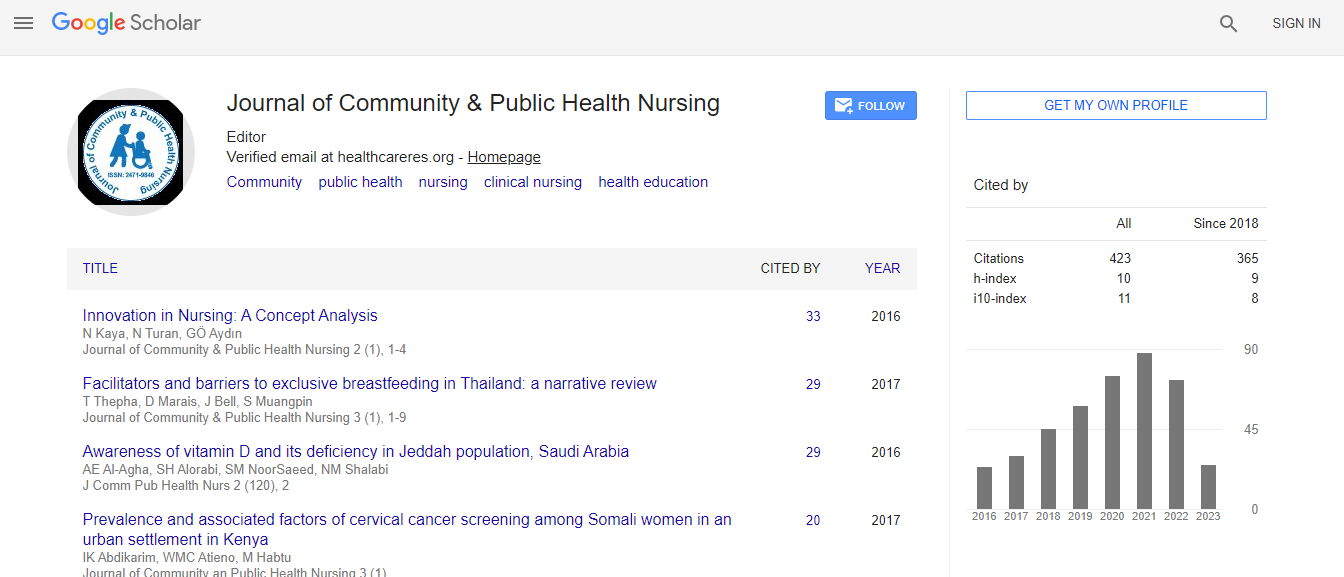Our Group organises 3000+ Global Conferenceseries Events every year across USA, Europe & Asia with support from 1000 more scientific Societies and Publishes 700+ Open Access Journals which contains over 50000 eminent personalities, reputed scientists as editorial board members.
Open Access Journals gaining more Readers and Citations
700 Journals and 15,000,000 Readers Each Journal is getting 25,000+ Readers
Google Scholar citation report
Citations : 739
Journal of Community & Public Health Nursing received 739 citations as per Google Scholar report
Journal of Community & Public Health Nursing peer review process verified at publons
Indexed In
- Google Scholar
- CiteFactor
- RefSeek
- Hamdard University
- EBSCO A-Z
- OCLC- WorldCat
- Publons
- Geneva Foundation for Medical Education and Research
- ICMJE
Useful Links
Recommended Journals
Related Subjects
Share This Page
Psychometric investigation and measurement of hunger and pleasure
7th International Conference on Public Health and Nursing
Dale M Hilty
Mt. Carmel College of Nursing, USA
Posters & Accepted Abstracts: J Comm Pub Health Nurs
Abstract
Fernandez’s (2001) Anger Parameters Scale (APS) conceptualizes anger activity according to frequency, duration, intensity, latency and threshold. The first three of the five parameters are based on the Multidimensional Anger Inventory (MAI) subscales while latency and threshold measures are related to pain and other perceptual responses. Thus, we have five parameters measuring: (1) How often one gets angry, (2) how long the anger lasts, (3) how strong the anger is, (4) how quick to anger and (5) how sensitive to provocation. Cronbach reliability estimates for an adult community sample were 0.85 (frequency), 0.90 (duration), 0.62 (intensity), 0.88 (latency) and 0.74 (threshold). Five anger parameters were extracted with a Principal Components Analysis (PCA). A separate PCA analysis based on the subscale inter-correlations led to a one-component solution termed, the Degree of maladaptiveness of anger. The parameters are internally consistent and supported by preliminary factor analytic investigation. Fernandez and colleagues (2014) report significant differences on the frequency, intensity and duration scales with the forensic sample (N=125) having high scores on these three parameters than a non-forensic (N=182) samples. The purpose of the educational intervention was to apply the Fernandez five parameters model (frequency, duration, intensity, latency and threshold) to the constructs of hunger and pleasure. Participants were 130 traditional undergraduate nursing students. Principal-axis factor analysis and Cronbach reliability estimates found two common factors were extracted for the hunger and pleasure constructs with reliability coefficients above 0.80.Biography
Dale M Hilty, Associate Professor at the Mt. Carmel College of Nursing. He has received his PhD in Counseling Psychology from the Department of Psychology at The Ohio State University. He has published studies in the areas of psychology, sociology and religion. Between April 2017 and April 2018, his ten research teams published 55 posters at local, state, regional, national and international nursing conferences.
E-mail: dhilty@mccn.edu

 Spanish
Spanish  Chinese
Chinese  Russian
Russian  German
German  French
French  Japanese
Japanese  Portuguese
Portuguese  Hindi
Hindi 
